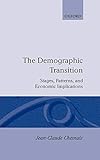The demographic transition : stages, patterns, and economic implications : a longitudinal study of sixty-seven countries covering the period 1720-1984 / Jean-Claude Chesnais ; translated by Elizabeth and Philip Kreager.
Material type: TextLanguage: English Original language: French Publication details: Oxford [England] : New York : Clarendon Press ; Oxford University Press, 1992. Description: xii, 633 p. : ill., maps ; 24 cmISBN: 0198286597; 9780198286592Subject(s): Demographic transition -- History | Economic development -- HistoryDDC classification: 304.6 LOC classification: HB887 | .C4813 1992Online resources: WorldCat details
TextLanguage: English Original language: French Publication details: Oxford [England] : New York : Clarendon Press ; Oxford University Press, 1992. Description: xii, 633 p. : ill., maps ; 24 cmISBN: 0198286597; 9780198286592Subject(s): Demographic transition -- History | Economic development -- HistoryDDC classification: 304.6 LOC classification: HB887 | .C4813 1992Online resources: WorldCat details | Item type | Current library | Collection | Call number | Copy number | Status | Date due | Barcode | Item holds |
|---|---|---|---|---|---|---|---|---|
 Text
Text
|
Dr. S. R. Lasker Library, EWU MPRHGD Corner | Non-fiction | 304.6 CHM 1992 (Browse shelf(Opens below)) | C-1 | Not For Loan | 22613 |
Browsing Dr. S. R. Lasker Library, EWU shelves, Shelving location: MPRHGD Corner Close shelf browser (Hides shelf browser)
| No cover image available |

|

|

|

|

|

|
||
| 304.60 BAN 2013 Bangladesh demographic and health survey 2011 : | 304.6 BOP 1969 Principles of demography / | 304.6 BOP 1969 Principles of demography / | 304.6 CHM 1992 The demographic transition : | 304.6 DEM 1992 Demographic applications of event history analysis / | 304.6 ESS 2008 An essay on the principle of population / | 304.6 LOO 1989 Looking at the population literature / |
Translation of: La transition démographique.
Includes bibliographical references and indexes.
TOC Introduction: the "theory" of demographic transition - its conciseness, diversity and flexibility - problems, methods and the field of enquiry. Part 1 Stages of demographic transition: demographic transition - the current position; the decline in mortality; the fertility decline; divergence and concordance; the migration transition; the notion of the cycle in demography - is post-transition fertility cyclical? Part 2 Forms of demographic transition: the types of demographic transition; chronology and typology of the ageing of populations; the transitional multiplier of population; industrial revolution and demographic revolution in the 18th century - the French-English paradox; European transitions from Malthus to Pincus; contemporary transitions - the strength of the model; revolution of mental attitudes and demographic revolution. Part 3 Economic implications of demographic transition: economic stagnation and neo-Malthusianism - two falsely opposed models; economic progress and demographic transition in poor countries - 30 years of experience, 1950-1980; secular growth in the industrial world; economic breakthrough in poor countries. Appendices: Crude birth-rates; total fertility rates; crude death-rates; infant mortality rates; real product.
Summary:
Demographic transition constitutes one of the most fundamental modern historical changes; people live much longer, have fewer children, and experience higher mobility. This book examines the basic mechanisms behind the modernisation of demographic behaviour. The author has marshalled an impressive array of statistical material relating to sixty-seven countries, half of them less developed countries. Most of the Read more...
Sociology
Saifun Momota

There are no comments on this title.